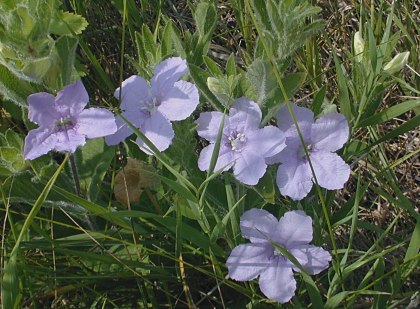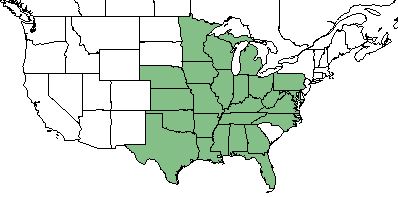Difference between revisions of "Ruellia humilis"
(→Ecology) |
(→Ecology) |
||
| Line 32: | Line 32: | ||
===Habitat=== | ===Habitat=== | ||
Common habitats for ''R. humilis'' include calcareous or mafic glades and woodlands, as well as prairies. <ref name= "Weakley"> Weakley, A. S. (2015). Flora of the Southern and Mid-Atlantic States. Chapel Hill, NC, University of North Carolina Herbarium.</ref> | Common habitats for ''R. humilis'' include calcareous or mafic glades and woodlands, as well as prairies. <ref name= "Weakley"> Weakley, A. S. (2015). Flora of the Southern and Mid-Atlantic States. Chapel Hill, NC, University of North Carolina Herbarium.</ref> | ||
| + | |||
| + | ''R. humilis'' can grow in any textured soil, coarse, medium and fine. <ref name= "USDA"> [https://plants.usda.gov/core/profile?symbol=CEAM USDA Plant Database]</ref> | ||
| + | |||
| + | This forb has a medium tolerance to drought, and is very tolerant of shade. <ref name= "USDA"> [https://plants.usda.gov/core/profile?symbol=CEAM USDA Plant Database]</ref> | ||
<!--Natural communities, human disturbed habitats, topography, hydrology, soils, light, fire regime requirements for removal of competition, etc.--> | <!--Natural communities, human disturbed habitats, topography, hydrology, soils, light, fire regime requirements for removal of competition, etc.--> | ||
| − | + | ===Phenology=== | |
| + | Flowering typically occurs during the summer months. <ref name= "USDA"> [https://plants.usda.gov/core/profile?symbol=CEAM USDA Plant Database]</ref> | ||
| + | <!--Timing off flowering, fruiting, seed dispersal, and environmental triggers. Cite PanFlora website if appropriate: http://www.gilnelson.com/PanFlora/ --> | ||
<!--===Seed dispersal===--> | <!--===Seed dispersal===--> | ||
<!--===Seed bank and germination===--> | <!--===Seed bank and germination===--> | ||
| − | + | ===Fire ecology=== | |
| + | ''R. humilis'' has no tolerance for fire. <ref name= "USDA"> [https://plants.usda.gov/core/profile?symbol=CEAM USDA Plant Database]</ref> | ||
| + | <!--Fire tolerance, fire dependence, adaptive fire responses--> | ||
<!--===Pollination===--> | <!--===Pollination===--> | ||
<!--===Use by animals===--> <!--Herbivory, granivory, insect hosting, etc.--> | <!--===Use by animals===--> <!--Herbivory, granivory, insect hosting, etc.--> | ||
Revision as of 13:33, 29 May 2018
| Ruellia humilis | |
|---|---|

| |
| Photo by John Hilty hosted at IllinoisWildflowers.info | |
| Scientific classification | |
| Kingdom: | Plantae |
| Division: | Magnoliophyta - Flowering plants |
| Class: | Magnoliopsida - Dicots |
| Order: | Scrophulariales |
| Family: | Acanthaceae |
| Genus: | Ruellia |
| Species: | R. humilis |
| Binomial name | |
| Ruellia humilis Nutt. | |

| |
| Natural range of Ruellia humilis from USDA NRCS Plants Database. | |
Contents
Taxonomic Notes
Synonym: R. humilis var. calvescens (Fernald), R. humilis var. frondosa (Fernald), R. humilis var. typica, R. humilis var. longiflora (A. Gray), R. humilis var. expansa (Fernald)
Variety: none
Description
R. humilis is a perennial forb/herb of the Acanthaceae family that is native to North America. [1]
Distribution
R. humilis is found in the eastern United States as far west as Texas, excepting South Carolina, New Jersey, New York, Delaware, Connecticut, Rhode Island, Massachusetts, Vermont, Maine, and New Hampshire. [1]
Ecology
Habitat
Common habitats for R. humilis include calcareous or mafic glades and woodlands, as well as prairies. [2]
R. humilis can grow in any textured soil, coarse, medium and fine. [1]
This forb has a medium tolerance to drought, and is very tolerant of shade. [1]
Phenology
Flowering typically occurs during the summer months. [1]
Fire ecology
R. humilis has no tolerance for fire. [1]